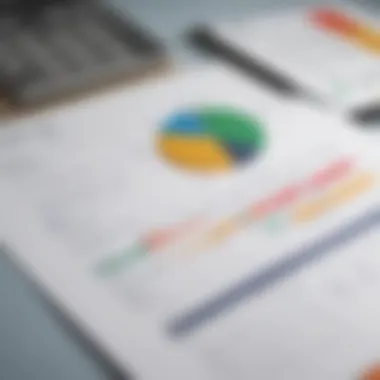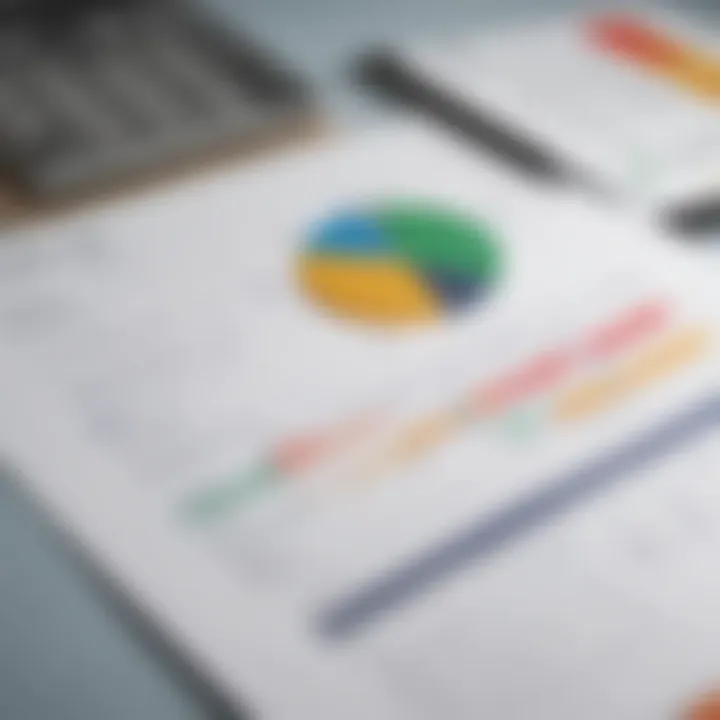Mastering Balance Sheets: A Guide for Beginners


Intro
When stepping into the world of finance, one can easily feel like a deer caught in headlights. The jargon, the figures, and the complexity can be overwhelming. Fear not, though, for understanding balance sheets is a foundational piece of financial literacy that can open doors to informed decision-making.
A balance sheet is essentially a snapshot of a company’s financial health at a specific moment in time. Imagine it as a photograph capturing the assets, liabilities, and equity of an enterprise all in one frame.
This guide aims to break down the intricacies of balance sheets into digestible bites. We'll cover the structure, key components, and real-world applications, allowing anyone from a curious novice to a seasoned investor to glean valuable insights.
By the end of it, you'll have a clear understanding of how to read and interpret balance sheets, which can significantly aid in evaluating investment opportunities or managing your personal finances more effectively.
Investment Dictionaries
In the journey of financial literacy, familiarizing oneself with the right terminology is akin to learning a new language. The following sections will help demystify some of the most critical financial terms and concepts that will appear in our exploration of balance sheets.
Key Financial Terms
- Assets: Anything owned by the company that has value. This can include cash, property, inventory, and equipment.
- Liabilities: These are the debt obligations a company has to third parties. Think loans, accounts payable, and other financial burdens that consume resources.
- Equity: The residual interest in the assets of the entity after deducting liabilities. Possibly viewed as the owner’s stake in the company.
- Current Assets and Liabilities: Short-term financial elements expected to be liquidated or settled within a year.
- Non-current Assets and Liabilities: Long-term financial components that typically last over a year, which include long-term debts or real estate investments.
"Understanding balance sheets is not just about numbers; it's about painting an accurate picture of a company’s worth."
Glossary of Investment Strategies
- Value Investing: Picking stocks that appear to be undervalued based on fundamental analysis, using balance sheets as one of the tools.
- Growth Investing: Focusing on companies with potential for substantial growth, often evaluated through future earnings rather than balance sheet metrics alone.
- Income Investing: Investing in assets that generate a regular income stream, like dividends, often found on balance sheets of companies that pay dividends.
Fostering this terminology not only aids comprehension but also enhances your confidence in navigating the financial landscape.
As we progress through the guide, keep these terms in mind, as they will recur, helping to knit together your understanding of balance sheets and their pivotal role in finance.
The Role of Balance Sheets in Finance
In the world of finance, balance sheets stand like a lighthouse guiding ships through a foggy night. They are crucial documents that encapsulate a company’s financial health at a specific point in time, serving as a window into its assets, liabilities, and equity. It’s important for anyone involved in finance — whether investors, financial advisors, or business owners — to grasp this fundamental tool and recognize its implications.
Understanding Financial Statements
At the heart of financial analysis lies the balance sheet. This document is part of a trio of financial statements that also includes the income statement and cash flow statement. Together, they provide a comprehensive overview of a business’s performance. The balance sheet specifically lays out what the company owns and owes, presenting a clear picture of net worth.
To decode a balance sheet, one must be familiar with its basic structure. It categorizes assets, liabilities, and shareholders' equity, with the fundamental equation of:
Assets = Liabilities + Equity
This equation is like a see-saw; if one side goes up, the other has to go down. Understanding these relationships can reveal several insights – like how leveraged a company might be or how efficiently it’s utilizing its resources.
In practice, analyzing a balance sheet can unveil key metrics such as liquidity ratios and solvency ratios, which tell a story about the short and long-term financial standing of the business.
Importance for Investors
For investors, balance sheets are not just pieces of paper; they are critical tools in making informed investment decisions. By examining a company’s balance sheet, investors can assess financial stability, which is a cornerstone of risk management. A firm that maintains a healthy balance sheet typically has enough cushion to weather the storms of economic downturns.
When diving into the numbers, investors look for several key indicators:
- Current Assets vs. Current Liabilities: This allows investors to evaluate if a company can meet its short-term obligations. A current ratio above 1 indicates that current assets can cover current liabilities.
- Debt-to-equity Ratio: A high ratio can be a red flag. It shows how much debt the company is using to finance its operation relative to its owner’s equity.
- Retained Earnings: This line indicates the total profits a company has reinvested into itself. High retained earnings can mean future growth, but it can also lead to concerns about dividends, depending on the company’s policy.
Investors also appreciate the time-travel aspect of balance sheets; they allow them to track a company’s growth over periods. By comparing balance sheets from different quarters or years, trends can be identified, which becomes invaluable when predicting future performance.
"A balance sheet is more than just a listing of numbers; it's a narrative of a company's journey, showcasing resilience, strategy, and foresight."
All in all, understanding the role of balance sheets in finance is not merely an academic exercise; it’s an essential skill for anyone looking to navigate the choppy waters of investments or manage a business effectively. They provide a level of granularity that can help dissect the noise in the market, illuminating paths that lead to smarter decisions.
Components of a Balance Sheet
A balance sheet serves as a snapshot of a company's financial position at any given moment. It lays out not just the assets owned but also the liabilities owed and the equity that belongs to shareholders. In this section, we break down the fundamental components of a balance sheet necessary for understanding its intricacies: assets, liabilities, and equity. Each element contributes pivotal information that helps stakeholders make informed judgments.
Assets: What They Are
Assets are the valuable resources that a business owns, and they are primarily divided into two categories, which are critical in understanding the financial health of an organization.
Current Assets
Current assets refer to resources that a company expects to convert into cash within a year. The hallmark characteristic of current assets is their liquidity, which means they can quickly be turned into cash or cash equivalents. This makes them a front-line tool for assessing immediate financial stability. Items such as cash, accounts receivable, and inventory are categorized under this umbrella.
A significant benefit of current assets is their role in managing day-to-day operations. Think of them as the lifeblood that keeps a business running smoothly. For instance, having readily available inventory allows a company to fulfill orders without delay, enhancing customer satisfaction and ultimately driving sales.
However, over-reliance on current assets can pose risks. If too much capital is tied up in unsold inventory or delayed payments, it can lead to cash flow challenges down the line. In this guide, understanding the balance of current assets is vital, as they can heavily influence liquidity ratios, revealing how well a company can cover its short-term obligations.
Non-Current Assets


Non-current assets, on the other hand, represent long-term investments owned by the company, usually expected to provide benefits for more than one year. This includes property, equipment, and intangible assets like patents. The distinctive quality of non-current assets lies in their depreciation, which reflects gradual wear and tear over time, affecting the overall financial picture.
These assets can be seen as the backbone of a company's operational capability. Owning high-value non-current assets can boost a company's creditworthiness, making it easier to secure loans for future growth. However, the drawback is the reduced liquidity compared to current assets; selling large machinery or buildings isn’t as swift as liquidating inventory.
Liabilities Explained
Liabilities are the obligations a company has to settle in the future, and similar to assets, they also categorize into current and long-term liabilities. Understanding these can illuminate the extent of a company's financial commitments.
Current Liabilities
Current liabilities encompass those obligations a company expects to clear within one fiscal year. This includes accounts payable, short-term loans, and accrued expenses. The significant feature of current liabilities is their immediacy; these are the bills that need to be paid soon. For investors, high levels of current liabilities compared to current assets can signal warning bells regarding potential liquidity issues.
Nonetheless, managing current liabilities can create a healthy balance for a business as well. If a company effectively leverages its short-term debts to finance inventory purchases, it could boost productivity and profitability. Yet caution is crucial, as failure to manage these obligations responsibly can spiral into cash flow troubles.
Long-Term Liabilities
Long-term liabilities encompass debts or obligations that extend beyond one year, such as bonds payable and long-term lease obligations. A key characteristic of long-term liabilities is that they often enable businesses to finance significant projects that can yield returns over time.
Thoughtfully structured long-term liabilities can serve as growth catalysts, providing necessary capital without immediate cash outflow. However, accumulating too much long-term debt can leverage a company's financial stability, thereby increasing risk related to interest rates and economic downturns.
Equity: The Owner's Perspective
Equity represents the owner's stake in the company after liabilities are settled. It tells how much the shareholders have invested, boiled down to two primary components: paid-in capital and retained earnings.
Paid-In Capital
Paid-in capital originates from the funds raised through issuing stock to investors. A stock offering brings in cash that fuels growth initiatives. The distinctive trait of paid-in capital is its role as a direct reflection of investor confidence in the company. High paid-in capital often correlates with ambitious growth plans, appealing to potential investors.
Yet, reliance on paid-in capital can lead to dilution of ownership if more shares are issued, which is a critical consideration for existing shareholders. It's a balancing act, weighing the funds raised against ownership percentages.
Retained Earnings
Retained earnings denote the cumulative profits that a company has reinvested instead of distributing as dividends. This piece of equity is pivotal for understanding a company's growth potential. Increased retained earnings signal a healthy reinvestment strategy, marking a company as capable of self-sustaining growth.
However, excessive retained earnings might cause friction with shareholders seeking dividends. Thus, while retained earnings can be beneficial for growth, they also necessitate prudent management to balance shareholder expectations and growth ambitions.
Ultimately, the components of a balance sheet interconnect in a dance of numbers that tells the unique story of a company's financial narrative. This intricate mosaic forms the foundation for analysis, helping stakeholders to make informed decisions.
The Balance Sheet Equation
The balance sheet equation is the backbone of any balance sheet. It succinctly encapsulates the relationship between a company’s assets, liabilities, and equity. The equation states that Assets = Liabilities + Equity. This basic formula is much more than mere algebra; it finds its significance in revealing the financial stability of a an organization. Each component shares a vital link to provide a complete picture of financial health. Investors, analysts, and financial advisors closely scrutinize this equation because it highlights how resources are financed.
Understanding this equation is crucial for several key reasons:
- Insight into Financial Position: Knowing how assets are funded (either through debt or owner’s investment) aids in evaluating risk and growth potential.
- Framework for Analysis: It serves as a structure for building financial ratios, which can signal underlying issues or performance indicators.
- Guidance for Stakeholders: Whether you’re an investor or a stakeholder, the balance sheet equation offers clarity, making it easier to gauge operational efficiencies and potential return on investment.
Fundamentals of the Equation
To grasp the balance sheet equation more thoroughly, let’s break down its individual components:
- Assets: These are the valuable resources owned by a company, including cash, inventory, property, and receivables. They can be classified as current (short-term) and non-current (long-term).
- Liabilities: Responsibilities or debts that the company owes. These can likewise be split into current liabilities, which are due within a year, and long-term liabilities, like bonds and mortgages.
- Equity: Represents the owner's claim on the assets after deducting liabilities. This is what is left for the owners after all debts have been settled. It typically includes paid-in capital and retained earnings.
The essence of the balance sheet is to ensure that for every asset, there is a corresponding claim (be it a liability or equity). This is a basic concept similar to the principle of double-entry accounting, where every transaction affects at least two accounts, ensuring that the equation remains in balance.
Real-World Applications
Understanding the balance sheet equation doesn't just stay within the comfortable walls of theory; it seeps into day-to-day financial decision-making. Here are a few real-world scenarios where this equation comes into play:
- Investment Decisions: Investors analyze a company's balance sheet to ascertain whether the sales growth is supported by adequate assets. It influences decisions on whether to buy, hold, or sell stock.
- Credit Analysis: Lenders often compute financial ratios derived from the balance sheet equation to assess creditworthiness. A high level of liabilities compared to equity might indicate higher risk.
- Financial Forecasting: By analyzing changes over time in the balance sheet equation, analysts can forecast future performance, set priorities for resource allocation, or make recommendations for operational improvements.
"The balance sheet equation isn’t just numbers; it’s the narrative of a company’s financial existence. Each figure tells a story of how resources are marshaled and managed."
Preparing a Balance Sheet
Creating a balance sheet is more than a mere exercise in accounting; it’s a vital process that provides insights into an organization’s financial health. For investors, financial advisors, and analysts, understanding how to prepare and analyze a balance sheet can lead to well-informed decisions. A balance sheet serves as a snapshot of a company’s assets, liabilities, and equity at a specific point in time, allowing stakeholders to assess liquidity, leverage, and overall financial stability.
The preparation of a balance sheet isn't just about numbers and columns; it demands careful consideration of several factors. Knowing what to include, how to classify assets and liabilities, and keeping accurate records are key elements of this process. Moreover, a well-structured balance sheet establishes credibility. When done right, it can enhance an organization’s appeal to potential investors by showcasing transparency and responsibility in financial reporting.
It’s important to remember that a well-prepared balance sheet can reveal both strengths and weaknesses in a company’s financial structure, directly affecting investment prospects.
Step-by-Step Guidelines
- Determine the Reporting Date: Start by selecting the exact date for which the balance sheet will reflect the company’s financial status. This could be the end of a fiscal year or quarter.
- Identify Assets: List all assets, starting with current assets which can be converted into cash within one year. Examples include cash, accounts receivable, and inventory. Then, move on to non-current assets like property, equipment, and long-term investments.
- List Liabilities: Identify current liabilities, such as accounts payable and short-term loans, that the business expects to settle within a year. Next, detail long-term liabilities, which include loans and financial obligations due beyond a year.
- Calculate Equity: Equity figures are derived from the residual interest in the assets after deducting liabilities. Include paid-in capital from shareholders and retained earnings that represent reinvested profits.
- Organize and Format: Arrange the assets on one side of the balance sheet and liabilities along with equity on the other side, ensuring that total assets equal the sum of liabilities and equity. This ensures compliance with the fundamental equation of accounting (Assets = Liabilities + Equity).
- Review and Finalize: Double-check the numbers for accuracy and clarity. Make sure to label each section clearly and maintain a professional format.


Common Mistakes to Avoid
Preparing a balance sheet can be a tricky business. Here are some common pitfalls:
- Neglecting Details: Failing to account for all transactions can lead to an incomplete picture of the financial standing of the company. Every asset and liability must be included.
- Misclassifying Items: Mixing up current and non-current assets or liabilities can distort the balance sheet. Clarity in classification is paramount for accurate analysis.
- Ignoring Changes Over Time: Balance sheets should reflect updated information. It’s easy to fall into the trap of using outdated figures, which can mislead stakeholders.
- Overlooking Notes Section: A balance sheet shouldn’t just be a list of numbers; it should include explanatory notes to clarify various entries, providing a more comprehensive view of the accounts.
- Automating Without Context: While accounting software can ease the work of preparing financial statements, it’s crucial not to rely solely on automated functions without understanding the underlying data. Always scrutinize generated statements, verifying their accuracy.
By following the step-by-step guidelines and avoiding common mistakes, individuals and organizations can create a reliable balance sheet that serves its intended purpose of conveying financial health.
Interpreting a Balance Sheet
Understanding how to interpret a balance sheet is akin to reading a roadmap for a company's financial health. It’s not just a collection of figures; rather, it tells a story about the organization’s assets, liabilities, and equity at a specific point in time. This snapshot provides insight into liquidity, solvency, and financial stability. Investors, financial advisors, and analysts rely on this information to make informed decisions. When one grasps how to interpret a balance sheet, it’s like having a magnifying glass that highlights the nuances often missed by the casual observer.
Key Ratios Derived from Balance Sheets
Current Ratio
The current ratio is a quintessential financial metrics that serves a critical role in evaluating a firm's ability to cover its short-term obligations. It’s calculated by dividing current assets by current liabilities. A ratio higher than 1 suggests the company has more current assets than liabilities, a condition generally viewed favorably. This is a beneficial choice for investors as it indicates a cushion during tough times. However, a glaring peculiarity surfaces when this ratio is too high; it may signal inefficiency in using assets to generate revenue.
- Key Characteristic: The current ratio focuses solely on short-term solvency, offering quick insights into immediate financial health.
- Advantages: It’s straightforward to calculate, providing a quick gauge of liquidity.
- Disadvantages: Relying solely on this might overlook long-term financial strategies and operational efficiency.
Debt-to-Equity Ratio
Shifting gears to the debt-to-equity ratio, this metric pulls back the curtain on a company's financial leverage. By comparing total liabilities to shareholders' equity, this ratio reveals how much debt is being utilized to finance operations. A lower ratio typically signals a less risky position for investors, as it indicates that less debt is taken on relative to equity.
- Key Characteristic: Focuses on the balance between debt and equity financing, highlighting how aggressively a company is leveraging its debt.
- Advantages: It helps investors assess risk levels and the stability of the financial structure.
- Disadvantages: Different industries may have varying norms for what's considered healthy, making comparisons sometimes misleading if not contextualized properly.
Analyzing Trends Over Time
Interpreting a balance sheet also involves observing trends over time. By scrutinizing multiple balance sheets from various periods, one can discern patterns in asset growth, shifts in liability levels, and changes in equity. This analysis unveils insights that static snapshots cannot provide. For example, if a company's current ratio is steadily decreasing over three quarters, it might indicate rising short-term financial strains that require immediate attention.
"An effective analysis considers both the numbers at hand and the broader economic context."
In summary, interpreting balance sheets is essential for stakeholders seeking to navigate the complexities of financial statements. By grasping key ratios and analyzing trends, one gains a more profound understanding of an organization’s fiscal narrative.
Common Terminology in Balance Sheets
Understanding the lingo in balance sheets is akin to deciphering a code. When wading through the waters of financial statements, familiarizing oneself with common terminology is crucial. The significance of grasping these terms can’t be overstated. It helps investors and analysts make sense of a company's financial health and future prospects. Without this knowledge, one might as well be reading a book in a foreign language.
Knowing the terms can make a world of difference. Investors, financial advisors, and analysts can glean insights into what each figure represents, aiding in decision-making. Understanding terminology diminishes ambiguity and fosters clarity, ensuring that everyone speaks the same financial language.
Definitions of Key Terms
In the realm of balance sheets, several key terms frequently pop up. Here’s a closer look:
- Assets: These are resources owned by a business or individual. They can be tangible, like equipment and buildings, or intangible, like trademarks and patents.
- Liabilities: These reflect what a company owes to others. Liabilities are the debts or obligations that must be settled in the future, whether through cash or goods.
- Equity: This represents the owner’s interest in the company, essentially what’s left after all liabilities are deducted from assets. It’s like the company’s net worth.
- Current Assets: Resources expected to be converted to cash or consumed within a year. Think of cash, inventory, and receivables.
- Long-Term Liabilities: Obligations extending beyond one year, such as mortgages or bonds payable.
These definitions can help demystify the balance sheet's structure, making it easier to analyze. Each component plays a role in creating a complete picture of a company’s financial standing.
Understanding Financial Jargon
The world of finance is often peppered with jargon. It’s easy to feel overwhelmed; you’re not alone if terms like "depreciation" or "working capital" make your head spin. Here’s a way to break it down:
- Depreciation: A method of allocating the cost of a tangible asset over its useful life. This affects the assets column and, consequently, the equity section.
- Working Capital: This is a measure of a company's operational efficiency. Calculated as current assets minus current liabilities, it shows whether a company can cover its short-term obligations.
- Liquidity: Refers to how easily an asset can be converted to cash without affecting its market price. High liquidity means quick access to cash, essential in times of need.
A solid grasp of these terms can transform the experience of examining a balance sheet from daunting to enlightening. It’s just like learning to ride a bike—you might stumble at first, but soon enough, you'll be cruising.
"Being financially literate is not only advantageous; it is essential for making informed decisions in both personal and professional realms."
This deeper dive into terminology fosters better discussions and deliberations among stakeholders at all levels. The more you know, the more impactful your insights will be.
Balance Sheets in Different Contexts
Understanding balance sheets is not just about crunching numbers; it's about grasping their relevance across different settings. Balance sheets serve as navigational beacons in both personal finance and business, offering insights that guide decision-making and future planning. Let's explore how balance sheets hold significance in these unique contexts, and why they matter to different stakeholders like investors and financial advisors.
Personal Finance Applications
When it comes to personal finances, balance sheets can be a game-changer. Think of them as a snapshot of an individual’s financial health. By outlining what you own against what you owe, they help to ground your financial goals in reality.
- Asset Tracking: A personal balance sheet allows individuals to track their assets—anything from real estate and cars to cash and investments. This comprehensive view can reveal surprising truths, like how much equity one has in their home or what contributions their retirement accounts can bring down the line.
- Debt Management: On the flip side, it's essential to keep tabs on liabilities. Knowing how much one owes—be it student loans, credit card debt, or mortgages—gives insight into overall financial leverage. Individuals can make informed decisions about paying down high-interest debts or planning for larger purchases.
- Planning for the Future: Regularly maintaining a personal balance sheet is a key part of a sound financial strategy. It can aid in goal setting, whether it’s buying a new car or saving for a child's education.
As one well-known financial expert puts it:
"A personal balance sheet is not just a document; it’s a mirror reflecting your financial success and areas needing improvement."


Business Balance Sheets
In the realm of business, balance sheets take on a slightly different role but remain equally vital. For organizations large and small, they are more than just compliance documents; they serve as critical tools for strategic management and investment decisions.
- Assessing Financial Health: A business balance sheet is instrumental for stakeholders, including investors, analysts, and lenders, who seek to understand the financial stability of a company. By analyzing the balance sheet data, stakeholders can discern the firm’s capacity to meet its short-term and long-term obligations.
- Funding Decisions: When a company seeks funding, whether through loans or equity, investors will scrutinize the balance sheet. They look for healthy ratios of assets to liabilities, signs of solid equity positions, and growth trends. This information can significantly influence whether funds are allocated.
- Operational Insight: Furthermore, businesses often use balance sheets to evaluate their operational efficiency. Tracking how assets are utilized in generating revenues helps managers pinpoint areas that might benefit from optimization or investment.
Maintaining accurate and timely balance sheets can steer a business towards profitable paths, ensuring that decision-makers have the data they need.
Comparing Balance Sheets Across Industry
When jumping into the world of finance, comparing balance sheets across different industries opens the door to a clearer understanding of how various sectors operate. It's like being given a cheat sheet into the inner workings of businesses, helping you identify strengths, weaknesses, and opportunities that might not be immediately apparent just by looking at a single company's balance sheet. This method of analysis is essential for anyone striving to make informed decisions in investments or business strategy.
Variances Among Sector Benchmarks
In any given industry, there are benchmarks that help in understanding typical financial health. For instance, a tech startup might show a distinct profile compared to a manufacturing giant. These variances can be attributed to several factors, including:
- Capital Structure: Different industries have varied needs for capital. Tech companies may rely more on equity financing, while heavy industries often take on more debt.
- Asset Allocation: A retail company may have significant inventory assets as opposed to a service-oriented firm which may list human capital as a primary asset.
- Operating Expenses: Different sectors have different cost structures. For instance, healthcare companies might face higher regulatory costs compared to commercial airlines.
Understanding these variances can guide analysts as they assess companies' balance sheets and use the data to gauge performance relative to peers.
Understanding Industry Trends
Industry trends also play a crucial role in interpreting balance sheets. Keeping an ear to the ground on trends can provide insights that numbers sometimes don’t tell directly. For example:
- Shift to Digital: In recent years, companies have increasingly invested in technology. The balance sheets of businesses that proactively adapt to digital transformation may feature higher intangible assets like software and intellectual property.
- Sustainability Initiatives: Firms focused on sustainability may show rising investments in green technologies. Understanding the impact of these changes reflects how companies plan for long-term growth amidst shifting consumer preferences.
- Market Cycles: Cyclical industries like automotive production fluctuate with economic cycles, which impacts their balance sheet significantly. Recognizing where a company stands in this cycle aids in making predictive assessments about future performance.
Analyzing balance sheets across industries allows for not just a peek at individual company performance, but also a sweeping view of economic indicators and market health. It’s about piecing together the broader picture—seeing beyond the numbers.
By taking the time to dive into these variances and industry trends, investors and analysts position themselves to make more strategic choices, pushing through the clutter to find value and opportunity.
Resources for Further Learning
Navigating the complexities of balance sheets can feel like learning a new language, especially for those just starting their financial journey. This section is essential as it provides readers with the tools necessary for deeper comprehension. By understanding not only the basics but also the advanced nuances of balance sheets, individuals can make informed decisions that directly impact their financial health.
Learning resources play a vital role in one's educational journey; they offer different perspectives and insights, which can be instrumental in reinforcing knowledge. The ability to explore varied sources—from books to online courses—enriches understanding and provides practical guidance that theory alone often lacks. Engaging with these materials, whether during a quiet evening at home or throughout a structured course, can greatly enhance one's grasp of financial principles.
Books and Publications
Diving into books dedicated to financial literacy is like embarking on an enlightening journey. These resources provide comprehensive information packed with examples and visuals that help demystify balance sheets. Often, real-world scenarios presented in literature can illuminate concepts that might seem abstract at first.
A few noteworthy publications include:
- "Financial Statements for Dummies": A daunting title, yet it approaches the topic with an accessible tone, breaking down each component interpretively.
- "The Basics of Accounting": This book offers readers a well-rounded overview of accounting principles, with an entire section devoted to balance sheets that clarifies their function in the grand scheme of finance.
- "Understanding Financial Statements": A no-nonsense breakdown of how to read and analyze balance sheets alongside profit and loss statements, lending practical skills to the theoretical base.
Consider checking the Wikipedia page on Balance sheets for a foundational start. Various discussion threads on Reddit can also provide personal experiences where community members share insights on resources they found useful.
Online Courses and Workshops
In an increasingly digital world, online courses and workshops present an interactive learning opportunity. Many platforms offer specialized financial training that can cater to all levels of understanding.
- Coursera and edX have partnerships with renowned universities, providing courses that explore financial statements in depth, often led by expert instructors.
- LinkedIn Learning offers concise, targeted videos that cater to busy individuals looking to brush up on specific topics related to balance sheets, finance, and accounting principles.
- Local community colleges may offer workshops that not only provide theoretical knowledge but also practical applications, making it easy for attendees to ask questions and network with instructors and peers.
These resources collectively strengthen one's financial acumen, establishing a solid foundation for any future endeavors in finance or investing. As businesses evolve and financial environments change, keeping up with continuous learning is crucial.
"The best way to predict the future is to create it."
With the right tools at your disposal, you can not only understand balance sheets but also leverage them for strategic advantages in your financial dealings.
Culmination
A well-rounded understanding of balance sheets is a cornerstone for anyone engaging in financial activities. In this article, the importance of financial literacy has been emphasized—not only for seasoned investors but also for novices looking to make their mark. Balance sheets shed light on a company’s financial health, serving as an immediate snapshot of its assets, liabilities, and equity at any given moment. This transparency is crucial for decision-making, and knowing how to interpret these documents can empower investors and analysts alike.
Financial literacy also fosters an environment where individuals are equipped to analyze trends, evaluate company health, and make informed decisions. An individual who comprehends a balance sheet isn’t just passively looking at numbers; they’re engaging with a map of an organization's financial landscape. Understanding the nuances can dramatically impact investment strategies and enhance one's ability to navigate complex financial terrains effectively.
In this era of rapid financial change and uncertainty, the knowledge and skills related to financial documents become vital not just for investment, but for overall economic well-being. Everyone must take charge of their financial learning—a journey where balance sheets often serve as one of the first steps.
The Importance of Financial Literacy
Financial literacy goes beyond mere familiarity with balance sheets or spreadsheets; it encapsulates a range of skills that enable individuals to make informed money-related decisions. The more one understands financial statements, the more confidence they carry into investment discussions, personal finance planning, and even negotiations with financial advisors.
For example, an investor who can read between the lines of a balance sheet is like a seasoned sailor, able to navigate through both calm waters and turbulent storms. They understand the implications of rising liabilities or changing equity positions, which can be the difference between a lucrative investment and a costly mistake. Recognizing these signals often leads to proactive decisions rather than reactive ones, aligning with best practices in financial management.
Encouraging Continued Education in Finance
As the financial landscape becomes increasingly intricate, continuous education in finance is more paramount than ever. The learning process should never halt after familiarization with balance sheets; instead, it should evolve into a commitment to lifelong learning. This can be pursued through formal education, such as pursuing degrees or certifications, as well as informal avenues like attending workshops and webinars.
Subscribing to financial news platforms or following industry experts on social media is another pathway. Engaging with online communities, perhaps on platforms like Reddit or educational sites such as britannica.com, can also expand one's understanding by providing real-world insights and discussions that revolve around current events.
In summary, encouraging a shift towards continuous learning not only enhances an individual's understanding of finance but also fortifies their resilience in the face of economic challenges. It creates a community of informed individuals capable of navigating the financial waters with assurance and strategy.







